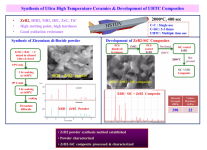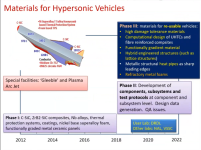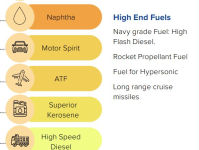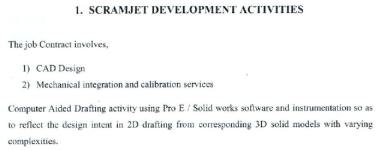I mean the project name was surya, not necessarily the ICBM itself would be named so? Its just project designated name. k-15 sagarika being project B-05LV. Seen loads of video on this Surya icbm on yt. But I always thought its rather project name centric. A proper ICBM can definitely have its own name, instead of being another Agni. Lets hope it exists truly. If k-15 can have land version, then K4 and others could also do that too & co-exist with the agnis in the SFC inventory."Surya" ICBM project has existed for long. I read about it in a book bought in 1999(परमाणु बम). Here is something to ponder:
Indian Hypersonic Propulsion Developments
- Thread starter Ashwin
- Start date
You are using an out of date browser. It may not display this or other websites correctly.
You should upgrade or use an alternative browser.
You should upgrade or use an alternative browser.
This is excellent, so DRDL have a frozen config for the Hypersonic LV and its that pic from the SAROD brochure earlier with the exposed cruise vehicle. Stage separation at 6.5M , not sure if flight would really be at 8M level or not, all config/testing theory etc were at 6-6.5M range before. But coupled with achieving the restart of unstarted scramjet engine part above, quite some achievement by the team.
This is certainly the ground launched version I think.
That fat booster itself is quite complex, in one of the lists before, one tech dev task is to develop more powerful boosters with very high specific impulse material.
Pity I could not find the full paper anywhere , just the abstract part.
In case anyone doubt, group of people presenting the paper are all DRDL HCM project group, Dr T.K. Ganesh Anavaradham, Project Director, HSTDV, DRDL.


This is certainly the ground launched version I think.
That fat booster itself is quite complex, in one of the lists before, one tech dev task is to develop more powerful boosters with very high specific impulse material.
Pity I could not find the full paper anywhere , just the abstract part.
In case anyone doubt, group of people presenting the paper are all DRDL HCM project group, Dr T.K. Ganesh Anavaradham, Project Director, HSTDV, DRDL.


India must develop hypersonic weapons
Possessing hypersonic weapons will always increase India’s diplomatic weight at global high tables. It will also provide massive strategic and tactical advantages against Pakistan and China.

 www.udayindia.in
www.udayindia.in
Possessing hypersonic weapons will always increase India’s diplomatic weight at global high tables. It will also provide massive strategic and tactical advantages against Pakistan and China.

India must develop hypersonic weapons
Possessing hypersonic weapons will always increase India’s diplomatic weight at global high tables. It will also provide massive strategic and tactical advantages against Pakistan and China.
Uhm so they are indeed very close to realising 400 sec (weapon configuration grade) action of scramjet engine (cruise vehicle) of HSTDV. Very good all round work and its just the beginning. Will post something later though I guess some may have already seen it.
Interesting bit of work initiated by DRDL , droplets to be measured includes the endothermic fuels, JP7 JP10 etcmissile fuels like the above post. Speed max is 800m/s ie about 2.3 mach inside combustor which might be the starting mach no for scramjet operation.
Alternatively it could be for normal ramjet operation too. Either way , an air-breathing propulsion related.


Alternatively it could be for normal ramjet operation too. Either way , an air-breathing propulsion related.


Throwback to the first HSTDV test, from the scientists speech back in 2020.
Institute Lecture on “The recent flight demonstration of hypersonic air-breathing cruise vehicle by India”
Title : “The recent flight demonstration of hypersonic air-breathing cruise vehicle by India”
Date : October 19, 2020 | Time : 3.00 pm
Abstract: Starting with the intense determination of the two brothers Orvile and Wilbur Wright at Kitty Hawk, North Carolina, and their success, the aspiration of flying at higher and higher speed in the atmosphere has led the mankind to a position where it is possible to conceive of aircrafts flying at speeds more than few times that of sound in air. When the flight is in hypersonic regime (M∞ >5.0), the burning of fuel must occur at supersonic speeds inside the combustor to allow the possibility of heat addition and minimise the total pressure loss and so, thrust loss. In turn, this allows propulsive efficiency of the hypersonic systems to be brought up to meaningful values and also contribute to reduced vehicle size and weight. The success of efficient design of such a transatmospheric hypersonic vehicles depends largely on the proper choice of the propulsion system which is capable of producing large thrust, demanded by the system. This type of vehicle uses supersonic combustion ramjet (scramjet) propulsion system.
The development of hypersonic air-breathing cruise vehicle has tremendous applications in high-speed transport, space access, national defence, etc. It is attractive for military operations and can provide significant payoff for offensive strike against time critical, hardened, deeply buried and heavily defended targets due to its longer range, shorter response time and enhanced effectiveness. Its reduced tracking by ground based radars compresses enemy's decision-making window, effectively enabling the hypersonic attacker to get inside an adversary's command, control, and battle management cycle.
Although, various countries including USA, Russia, China, UK, France and India are in the race to develop hypersonic airbreathing cruise vehicles; only a few practical flight tests of these vehicles have been conducted worldwide. Extensive R&D efforts are continuing for the design and testing of scramjet combustors for hypersonic vehicles. The flight trial of hypersonic air-breathing cruise vehicle (X-51) by USA for 210 sec duration is close to hypersonic weaponization program. Russia and China are also claiming the successful demonstration of hypersonic air breathing cruise missile; but no information is available in the open literature.
Recently, on September 7, DRDO, India has successfully test flown a vehicle integrated hydrocarbon fueled scramjet engine (cruise vehicle) in an autonomous mode. The cruise vehicle is put atop a solid rocket booster (launch vehicle) and carried to 32 Km altitude at Mach 6 conditions. The heat shield fairings which protected the cruise vehicle from aerodynamic heating during ascent phase were separated and the hydrocarbon fueled scramjet engine was ignited. The vehicle flown in power-on condition for 24 seconds before plunging into the sea. This maiden flight demonstration has proved many complex technologies and design tools for the development of hypersonic air breathing vehicles and put India in the league of the few advanced nations which possesses this complex technology.
Institute Lecture on “The recent flight demonstration of hypersonic air-breathing cruise vehicle by India”
Title : “The recent flight demonstration of hypersonic air-breathing cruise vehicle by India”
Date : October 19, 2020 | Time : 3.00 pm
Abstract: Starting with the intense determination of the two brothers Orvile and Wilbur Wright at Kitty Hawk, North Carolina, and their success, the aspiration of flying at higher and higher speed in the atmosphere has led the mankind to a position where it is possible to conceive of aircrafts flying at speeds more than few times that of sound in air. When the flight is in hypersonic regime (M∞ >5.0), the burning of fuel must occur at supersonic speeds inside the combustor to allow the possibility of heat addition and minimise the total pressure loss and so, thrust loss. In turn, this allows propulsive efficiency of the hypersonic systems to be brought up to meaningful values and also contribute to reduced vehicle size and weight. The success of efficient design of such a transatmospheric hypersonic vehicles depends largely on the proper choice of the propulsion system which is capable of producing large thrust, demanded by the system. This type of vehicle uses supersonic combustion ramjet (scramjet) propulsion system.
The development of hypersonic air-breathing cruise vehicle has tremendous applications in high-speed transport, space access, national defence, etc. It is attractive for military operations and can provide significant payoff for offensive strike against time critical, hardened, deeply buried and heavily defended targets due to its longer range, shorter response time and enhanced effectiveness. Its reduced tracking by ground based radars compresses enemy's decision-making window, effectively enabling the hypersonic attacker to get inside an adversary's command, control, and battle management cycle.
Although, various countries including USA, Russia, China, UK, France and India are in the race to develop hypersonic airbreathing cruise vehicles; only a few practical flight tests of these vehicles have been conducted worldwide. Extensive R&D efforts are continuing for the design and testing of scramjet combustors for hypersonic vehicles. The flight trial of hypersonic air-breathing cruise vehicle (X-51) by USA for 210 sec duration is close to hypersonic weaponization program. Russia and China are also claiming the successful demonstration of hypersonic air breathing cruise missile; but no information is available in the open literature.
Recently, on September 7, DRDO, India has successfully test flown a vehicle integrated hydrocarbon fueled scramjet engine (cruise vehicle) in an autonomous mode. The cruise vehicle is put atop a solid rocket booster (launch vehicle) and carried to 32 Km altitude at Mach 6 conditions. The heat shield fairings which protected the cruise vehicle from aerodynamic heating during ascent phase were separated and the hydrocarbon fueled scramjet engine was ignited. The vehicle flown in power-on condition for 24 seconds before plunging into the sea. This maiden flight demonstration has proved many complex technologies and design tools for the development of hypersonic air breathing vehicles and put India in the league of the few advanced nations which possesses this complex technology.



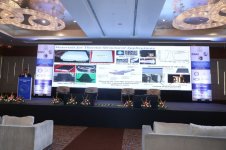










 , below part is helpful. There is a reason it is called
, below part is helpful. There is a reason it is called 




